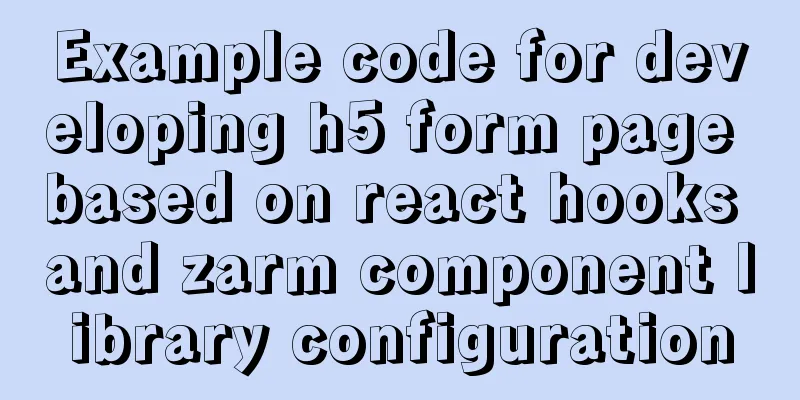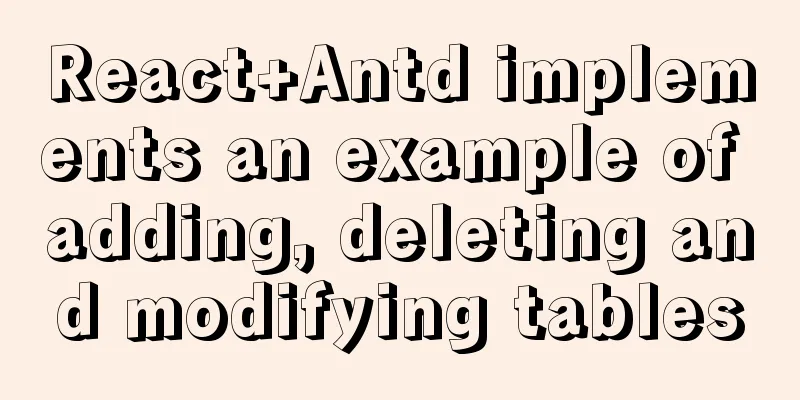Example code for developing h5 form page based on react hooks and zarm component library configuration

|
Recently, I have used React Hooks in combination with the zarm component library to develop a large number of h5 form pages based on js object configuration. As we all know, the functions of h5 forms are nothing more than the collection, verification, submission, and echo editing of form data. Usually, the arrangement is displayed in a row and column from top to bottom. Therefore, we considered encapsulating a configurable page generation solution from the beginning. Currently, there are many projects developed and launched based on this configuration. Let's share the ideas and implementation. Usage scenariosAny h5 page containing a form (use the zarm library, or adapt your own library) Target
Before writing, I referred to some solutions on the market. Most of them define a set of formats by defining json schema. For example, Alibaba's form-render defines the form through JSON Schema, has a visual editor configuration, exports json files, dynamic rendering, and so on. Here, we will take Ali form-render as an example to talk about some of its shortcomings (for its advantages, please refer to the official website for publicity) Some defects of form-render or ideas1. My target is h5. Form-remder is currently only a PC backend form configuration solution, providing antd and fusion themes, and does not support h5 by default 2.form-render supports extended components. It maintains a mapping table internally, which maps the mapping relationship between data types and components. For example, the mapping relationship between the data types of the antd theme and the antd components is as follows. If I have my own h5 component library/a third-party company uses it uniformly, I need to configure the extension myself, which is troublesome.
// For example, the mapping under antd is as follows:
export const mapping = {
default: 'input',
string: 'input',
array: 'list',
boolean: 'checkbox',
integer: 'number',
number: 'number',
object: 'map',
html: 'html',
'string:upload': 'upload',
'string:date': 'date',
'string:dateTime': 'date',
'string:time': 'date',
'string:textarea': 'textarea',
'string:color': 'color',
'string:image': 'input',
'string:email': 'input',
'string:url': 'url',
'range:date': 'dateRange',
'range:dateTime': 'dateRange',
'*?enum': 'select',
'array?enum': 'checkboxes',
};If you have used/developed json schema-based tools such as form-render, there is a requirement that is more troublesome to handle, such as the linkage processing of form fields. form-render provides a limited number of linkage attributes, such as ui:options, ui:disabled, ui:hidden, etc. In this way, in addition to mastering the data types defined by form-render, data type theme component mapping, and various attributes associated with components, you also need to memorize additional linkage attributes. It is nothing more than learning the complexity of a new programming language, so a visual interface is needed to assist in editing.
import React, { useState } from 'react';
import FormRender from 'form-render/lib/antd';
const schema = {
type: 'object',
properties:
select: {
title: 'Single Choice',
type: 'string',
enum: ['a', 'b'],
enumNames: () => ['Show input box', 'Hide input box'],
'ui:disabled': (formData, rootValue) => rootValue.input1.length > 5,
'ui:widget': 'radio',
},
input1: {
title: 'Input box',
description: 'Try to enter more than 5 characters',
type: 'string',
'ui:hidden': (formData, rootValue) => formData.select === 'b',
},
},
};
const Demo1 = () => {
const [formData, setFormData] = useState({});
return (
<FormRender schema={schema} formData={formData} onChange={setFormData} />
);
};
export default Demo1;4. This configuration of json is suitable for non-developers to quickly create form functions, but it is not suitable for developers to develop extensions. For example, I want to put a mixed text and image between two input boxes. (Develop a custom component to mount it separately?) javascript object solutionTherefore, solutions such as Ali form-render that use json configuration to achieve dynamic rendering cannot meet the survival criteria of coders: simple, fast, breakthrough, and win-win. If json is replaced with javascript object, the configuration and expansion capabilities will be different. Here we still use the overall idea of form-render, but change the type from string, number, boolean, array, object, html and other data types to Function. A Function is a React component, such as the Input component of antd-mobile and zarm. Because this article is based on zarm, the following will be based on zarm (also applicable to third-party mobile/pc terminals such as antd-mobile and vue), for example, the following configuration
import React, { useState, useEffect } from 'react';
import FormRenderer from 'zarm-form-render';
import { Input, Cell, Radio, Select, DateSelect, Button, Toast, Panel } from 'zarm';
export default function App() {
const [data, setData] = useState({});
const layoutData = [
{
type: Input,
label: 'Name of the insured',
placeholder: 'Please fill in',
name: 'name',
},
{
type: Radio.Group,
label: 'gender',
name: 'gender',
elProps: {
type: 'button',
ghost: true,
},
items: [
{ label: '男', value: 'male' },
{ label: '女', value: 'female' },
],
},
{
render() {
if (!data.gender) return null;
return <Cell title="You are" description={data.gender === 'male' ? 'Boy' : 'Girl'}></Cell>;
},
},
{
type: Select,
label: 'Favorite Fruit',
name: 'favfood',
elProps: {
dataSource: [
{ label: 'apple', value: 'apple' },
{ label: 'banana', value: 'banana' },
],
},
},
{
type: DateSelect,
label: 'Date of Birth',
title: 'Insured person's date of birth',
placeholder: 'Please select',
name: 'birthday',
min: '1900-01-01',
},
{
type: Input,
label: 'Mobile phone number',
placeholder: 'Please fill in',
name: 'mobile',
},
{
render() {
return <div style={{ margin: '30px 6px',}}></div>;
},
},
{
render() {
return (
<Panel title="Content you entered">
<div style={{ margin: '10px 6px' }}>{JSON.stringify(data)}</div>
</Panel>
);
},
},
];
return (
<div>
<FormRenderer layoutData={layoutData} data={data} setData={setData} />
<Button block theme="primary" onClick={() => Toast.show(JSON.stringify(data))}>
OK</Button>
</div>
);
}A form is defined by an array. The object type is the component to be rendered, name is the key for collecting data, and other properties define other props of the component. Based on which library, refer to the component API documentation of the relevant library for configuration. For some special/non-existent components, we define the render function for dynamic rendering, and then there is nothing else, all of which are the React you are familiar with. Finally, we can define our own FormRender, which accepts a one-dimensional array to arrange form items from top to bottom (render is not limited to form items, you can render any content), a data for data collection, and a setData for data update (derived from React Hooks useState). It's that simple, the source code is as follows
import React from 'react';
import { Cell, Radio, DateSelect, Select } from 'zarm';
// For situations where configuration is not possible (such as custom components, components that need to be displayed based on conditions, etc.), please use the render method.
// getJSON() returns json dynamically
// render() Custom render
export default function FormRenderer({ layoutData, data, setData }) {
const onFiledChange = (name, value) => {
let v = value;
// for Select ctrl
if (Array.isArray(value)) {
v = value.map((item) => item.value)[0];
}
setData({ ...data, [name]: v });
};
const onChangeFactory = (name) => (value) => onFiledChange(name, value);
return (
<div className="renderer">
{layoutData.map((item, idx) => {
if (typeof item.getJSON === 'function') {
item = item.getJSON();
}
if (typeof item !== 'object' || !item) return null;
const {
name,
type,
description,
items,
elProps = {},
cellProps = {},
render,
...props
} = item;
if (typeof render === 'function') {
return render();
}
let children = [];
if (Array.isArray(items) && type === Radio.Group) {
children = items.map((it, idx1) => (
<Radio value={it.value} key={idx1}>
{it.label}
</Radio>
));
}
props.value = data[name];
props.onChange = onChangeFactory(name);
if (type === Select) {
props.dataSource = items;
}
if (type === DateSelect || type === Select) {
props.onOk = props.onChange;
delete props.onChange;
props.onChange = elProps.onChange;
}
return (
<Cell key={idx} title={item.label} description={description} {...cellProps} name={name}>
{React.createElement(type, { ...props, ...elProps }, ...children)}
</Cell>
);
})}
</div>
);
}Configuration Instructions
import * as React from 'react';
export interface Item {
type: React.Component; // component type, such as Input, etc. name: string; // key
items?: Array<any>; // dataSource
description: string; // Cell description
label?: string; // Cell title
render?: () => React.ReactNode; //Custom render
getJSON?: () => object | null; // Dynamically return Item configuration elProps?: object; // Component props configuration, for example, if type is Input, elProps will be configured to Input
cellProps?: object; // cell props configuration}
export interface Props {
layoutData: Array<Item>; // Form layout configuration data: object; // Data storage, name as key, content as value
setData: () => void; // data update}
interface FormRenderer extends React.FC<Props> {}
declare const FormRenderer: FormRenderer;
export default FormRenderer;The above code has the following effect:
The only disadvantage of this method is that it cannot be stored in the database persistently like JSON. The advantage is that it can unify the mobile and PC form configuration development, reduce a lot of boilerplate code and nesting, and can unify the processing of data access and verification, as well as the arrangement of form items. This is the end of this article about developing h5 form pages based on react hooks and zarm component library configuration. For more relevant react hooks and zarm component library content, please search for previous articles on 123WORDPRESS.COM or continue to browse the following related articles. I hope you will support 123WORDPRESS.COM in the future! You may also be interested in:
|
<<: Docker container introduction
>>: Tutorial on Migrating Projects from MYSQL to MARIADB
Recommend
Example code for CSS to achieve horizontal lines on both sides of the text
This article introduces the sample code of CSS to...
js to realize the rotation of web page pictures
This article shares the specific code of js to re...
The leftmost matching principle of MySQL database index
Table of contents 1. Joint index description 2. C...
Design Theory: Textual Expression and Usability
<br />In text design, we usually focus on th...
Summary of commonly used tags in HTML (must read)
Content Detail Tags: <h1>~<h6>Title T...
Detailed explanation of setting up DNS server in Linux
1. DNS server concept Communication on the Intern...
Introduction to possible problems after installing Tomcat
1. Tomcat service is not open Enter localhost:808...
Use CSS variables to achieve cool and amazing floating effects
Recently, I found a fun hover animation from the ...
LayUI+Shiro implements a dynamic menu and remembers the example of menu expansion
Table of contents 1. Maven Dependency 2. Menu rel...
Detailed explanation of loop usage in javascript examples
I was bored and sorted out some simple exercises ...
Docker data management and network communication usage
You can install Docker and perform simple operati...
Teach you how to install mysql database on Mac
Download MySQL for Mac: https://downloads.mysql.c...
Implementation principle and configuration of MySql master-slave replication
Database read-write separation is an essential an...
Detailed tutorial on how to modify the root password after forgetting it in MySQL 5.7
Preface For a long time, the application and lear...
Example of how to build a Mysql cluster with docker
Docker basic instructions: Update Packages yum -y...












